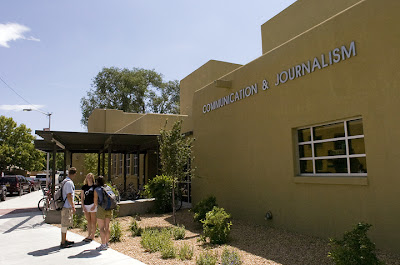 This is the University of New Mexico’s newly remodeled Communications and Journalism School. Being on the historical registry, the exterior retained all the architectural character of its 1949 era Spanish-Pueblo Revival design.
This is the University of New Mexico’s newly remodeled Communications and Journalism School. Being on the historical registry, the exterior retained all the architectural character of its 1949 era Spanish-Pueblo Revival design. The refurbish job seems pretty good. There are state of the art classrooms with computer projectors, several large computer labs and a suite of administrative offices. The offices for instructors and professors are still small. After the first semester, the building seems to be functioning fine.
The refurbish job seems pretty good. There are state of the art classrooms with computer projectors, several large computer labs and a suite of administrative offices. The offices for instructors and professors are still small. After the first semester, the building seems to be functioning fine. It was originally the Journalism building, printing plant and post office. I first visited it in Aug. 1967 during the week long New Mexico Interscholastic Press Association Workshop. At the time, I thought I was a well-seasoned student newspaper and yearbook photographer, having been published for all of three years.
It was originally the Journalism building, printing plant and post office. I first visited it in Aug. 1967 during the week long New Mexico Interscholastic Press Association Workshop. At the time, I thought I was a well-seasoned student newspaper and yearbook photographer, having been published for all of three years.The then UNM Journalism School's Chairman and Professor Tony Hillerman was the coordinator and master of ceremonies at all the evening convocations.
Now, 40 years later, I seem to be coming full circle. I attended a class in the same room this semester as I had back then. A new computer-driven console that runs a digital projector now replaces a simple wooden lectern. The picture of the Hindenburg disaster is gone; blank white walls give tribute to the meaning of today’s sense of journalism.
 There currently is little art in the building. There are a handful of Photojournalism Professor Miguel Gandert’s local cultural portraits and little else in the public areas. However, there is this 1973 sculpture by J.D. Hammond, “Give light and the people will find their own way.” It is made with parts from the printing process of the day, specifically a linotype bed and two different kinds of printing plates. The saying is the motto of the Albuquerque Tribune, written by Carl Magee who sold his one-year old Magee's Independent paper to Scripps Howard publishing company as the Tribune in 1923. Magee remained as editor.
There currently is little art in the building. There are a handful of Photojournalism Professor Miguel Gandert’s local cultural portraits and little else in the public areas. However, there is this 1973 sculpture by J.D. Hammond, “Give light and the people will find their own way.” It is made with parts from the printing process of the day, specifically a linotype bed and two different kinds of printing plates. The saying is the motto of the Albuquerque Tribune, written by Carl Magee who sold his one-year old Magee's Independent paper to Scripps Howard publishing company as the Tribune in 1923. Magee remained as editor. This is the current flag of the Albuquerque Tribune. A “flag” is the journalistic name for the graphic logo used on the front page of a newspaper.
This is the current flag of the Albuquerque Tribune. A “flag” is the journalistic name for the graphic logo used on the front page of a newspaper.The Tribune is owned by E.W. Scripps and is operating under a joint operating agreement since the 1930s. A JOA is an exception to the monopoly laws and anti-competition rules. It allows a morning and evening newspaper in a city to join forces and share certain aspects of the newspaper business, while still competing. The Albuquerque Publishing Company, owned by the Lang family, is headed by the eldest son of the former publisher, Thomas J. Lang.
The Tribune has a long history. Magee uncovered the Tea-Pot Dome scandal. Ernie Pyle was a Tribune writer who went on to be considered one of the great World War II correspondents. The Tribune’s Eileen Welsome received the national reporting Pulitzer Prize in 1994 for her coverage of secret radiation experiments conducted by the government almost 50 years earlier.

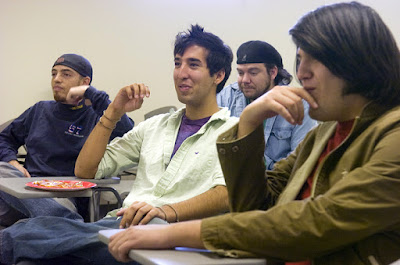 These students are part of the editorial staff at the UNM Daily Lobo: Design Director Colin Bridge, Editor in Chief Christopher Sanchez, Rhian Hibner, and Managing Editor Damian Garde. They also represent the leadership and core of the UNM campus chapter of the Society of Professional Journalists.
These students are part of the editorial staff at the UNM Daily Lobo: Design Director Colin Bridge, Editor in Chief Christopher Sanchez, Rhian Hibner, and Managing Editor Damian Garde. They also represent the leadership and core of the UNM campus chapter of the Society of Professional Journalists. SPJ invited Phill Casaus, left, to speak before at SPJ's November meeting about the state of the newspaper business in Albuquerque. He has been with the Albuquerque Tribune for the past 11 years as editor, managing editor and assistant managing editor. Casaus doesn’t expect to make it to 12 years. The Tribune appears doomed.
SPJ invited Phill Casaus, left, to speak before at SPJ's November meeting about the state of the newspaper business in Albuquerque. He has been with the Albuquerque Tribune for the past 11 years as editor, managing editor and assistant managing editor. Casaus doesn’t expect to make it to 12 years. The Tribune appears doomed.“It’s the last job in America where you put your name on it,” Casaus said speaking of the importance of young journalists to get their reporting right; to be accurate. He spoke enthusiastically about the craft as his paper faces a crisis.
Scripps offered the Tribune for sale at the same time it announced its dissolution of the Joint Operating Agreement with the Albuquerque Journal.
The Tribune’s name will die unless a qualified buyer is found.
However, the 1933 agreement with the Tribune's parent organization, the Albuquerque Publishing Company, now the Journal Publishing Company, is over whether the Tribune’s name continues or not.
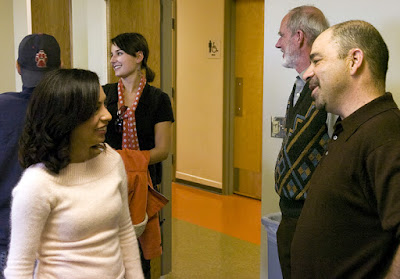 Casaus talked with student Margaret Ybarra, who may have been one of the last interns at the Trib. Ybarra is a photographer and has since the internship she has written for Albuquerque Arts and is the Assistant Cultural Editor at the Daily Lobo.
Casaus talked with student Margaret Ybarra, who may have been one of the last interns at the Trib. Ybarra is a photographer and has since the internship she has written for Albuquerque Arts and is the Assistant Cultural Editor at the Daily Lobo.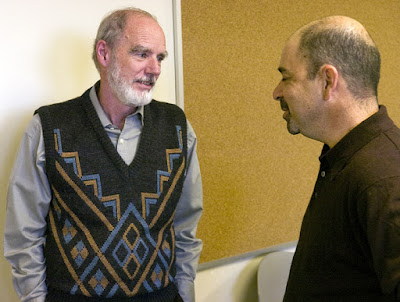 UNM’s Journalism Lecturer Dennis Herrick, left, is the SPJ faculty advisor. He has a great deal of experience with newspapers, having been a reporter, editor, owner/publisher and even a broker, selling newspaper companies. He teaches Media Management, and has written a textbook, Media Management In the age of Giants: Business Dynamics of Journalism. Last summer, a couple of weeks before Scripps announced the demise of the Tribune, Herrick predicted in his copy-editing class that the Tribune was not long for this world. He admits that he had no idea that his prognostication would come true so quickly.
UNM’s Journalism Lecturer Dennis Herrick, left, is the SPJ faculty advisor. He has a great deal of experience with newspapers, having been a reporter, editor, owner/publisher and even a broker, selling newspaper companies. He teaches Media Management, and has written a textbook, Media Management In the age of Giants: Business Dynamics of Journalism. Last summer, a couple of weeks before Scripps announced the demise of the Tribune, Herrick predicted in his copy-editing class that the Tribune was not long for this world. He admits that he had no idea that his prognostication would come true so quickly.Casaus clearly has his head down putting out a paper six-days a week and was not aware of the details of the management of the publishing agreement. He did not know what the split of the JOA profits were. According to Scripps quarterly report filing with the U.S. Securities and Exchange Commission, the answer is 40 percent of the profits. “[W]e will continue to own an approximate 40% residual interest in the Albuquerque Publishing Company,” until 2022 when the JOA expires.
There is speculation that the sales offer is simply a method of keeping the Department of Justice from seriously looking into the JOA’s profit schedule.

 Tom Carroll, left, is president of D.W. Turner, a local public relations firm. Carroll and Doug Turner have made an offer on the Tribune; apparently the only one made by Scripps' deadline.
Tom Carroll, left, is president of D.W. Turner, a local public relations firm. Carroll and Doug Turner have made an offer on the Tribune; apparently the only one made by Scripps' deadline.What does D.W. Turner get if they buy the Tribune? They get the name of a failing newspaper, one that, along with most afternoon papers in this country, has shrinking readerships. They also would get four aging automobiles, some old computers, office equipment and furniture. The potentially most valued asset is the web domain name. Employees appear to be negotiable, but not part of any up-front offer.
What they do not get are any of the benefits of the JOA: access to the presses, advertising or circulation staffs.
Anyone wanting to take over the afternoon newspaper niche might be better off starting from scratch.
 There have been several people who are or were Tribune staffers in the news of late.
There have been several people who are or were Tribune staffers in the news of late.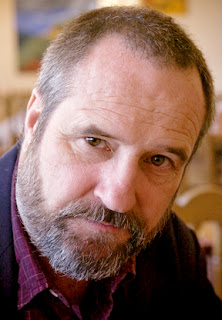 Dennis Domrzalski, left, was a Tribune staffer for 12 years starting in the mid-1980s.
Dennis Domrzalski, left, was a Tribune staffer for 12 years starting in the mid-1980s.He’s bounced around since: he was the news editor at the Alibi, a writer at New Mexico Business weekly, a radio newscaster at the now defunct, 106.3 KAGM FM, and currently is spokesman for the Middle Rio Grande Conservancy District. He also has written a book, “I Got Stinky Feet” and has blogged on occasion. He has a current offering, f-brilliant. He wrote a piece “The Tribune's Psychosis, A Few Reasons The Tribune Failed.” It’s worth the read. I hope Domrzalski continues blogging a little longer than his last effort, Spin Free, with its five postings.
He last wrote of Anna Politkovskaya,the murdered Russian journalist and critic of President Vladimir Putin: “Count your blessings for having been born in America. You've got it incredibly easy compared to everyone else in the world.”
Just because Domrzalski was called on the fact that Politkovskaya was born in America to Russian diplomats stationed in New York at the United Nations was no reason to go away for a year. Welcome back anyway.

 Michael Amedeo Tumolillo, left, works under his middle name Amedeo. You met him here, when he spoke to my advanced reporting/multimedia journalism class a year ago. He was the video producer at the Tribune, but has left. He secured work as Web producer at the International Herald Tribune – Asia-Pacific, in Hong Kong.
Michael Amedeo Tumolillo, left, works under his middle name Amedeo. You met him here, when he spoke to my advanced reporting/multimedia journalism class a year ago. He was the video producer at the Tribune, but has left. He secured work as Web producer at the International Herald Tribune – Asia-Pacific, in Hong Kong.The International Herald Tribune is owned by the New York Times Company and Amedeo spent a week in New York obtaining some in-service training before heading to the Far East.

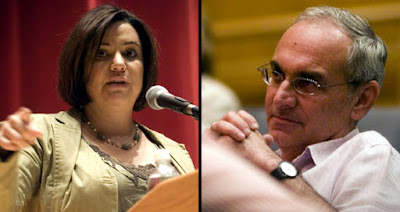 Alisa Valdes-Rodriguez, left, spoke at the University of New Mexico, in August of 2006 as father, UNM Sociology Professor Nelson Valdes, right, listened to her.
Alisa Valdes-Rodriguez, left, spoke at the University of New Mexico, in August of 2006 as father, UNM Sociology Professor Nelson Valdes, right, listened to her.Albuquerque Tribune political reporter Kate Nash wrote, Tue. Nov. 27, 2007, that Valdes-Rodriguez wants to run for congress.
Valdes-Rodriguez had written Tues. Nov. 20, “Testing the Waters for Congress,” that she was raising money to examine the possibility of running for democratic nomination for the New Mexico Congressional District 1 on her blog, “The Latina (L)it Girl,” now under the title Multiplicative Identity and her MySpace page. She has at least a half dozen blogspots and web-pages.
I am amazed at the thinking, talent, and boundless energy Valdes-Rodriguez seems to display. She is a former journalist, a blogger who acts like a journalist, a best selling novelist, and a screenwriter who is bringing her first book, The Dirty Girls Social Club, to production as a Hollywood movie.
She is extremely sharp, tough, and all too human, at the same time. I won’t point out her flaws, because if one follows her writing, she does an excellent job of exposing them herself. I wouldn’t do it for another reason; though they seem like flaws, she uses them as strengths and I’m not going to dispute her. In politics, the public is unlikely to embrace her brutal honesty. It seems they wish to vote for people who lie to them.
There were some problems that would face Valdes-Rodriguez in a run for the House. The first problem is her house, her residence. She moved in the summer from Albuquerque’s North Valley to Scottsdale, Ariz., in what she described as a necessary move. Now she seems to hate Scottsdale, recently writing that her neighborhood association is dictating what flags residents may fly; the American flag is one of the few still approved. Her liberal sensibilities seem offended by "my adopted home state," Arizona’s conservative culture. The Constitution requires a candidate to be an inhabitant in the state at the time they are elected. So it’s time for her to come home.
It brings her to the other point, that, no matter how smart and clever she is, she has amassed a huge written history of blunt and even sometimes vulgar comments on almost every topic of concern to our society. Though it is oft-heard that voters want an honest person who speaks their mind, the reality is that as voters, citizens have an abysmal record of not paying attention to the issues or what is happening in the political arena.
Political consultants and handlers try to limit their candidates to a few simple points and then repeat them until Election Day. Unfortunately, those political operatives are usually right, because so many citizens are lucky to even be able to name the top tier of candidates and might only have a limited range of familiarity with the names of those running in the lower ballot position races.
To her credit, Valdes-Rodriguez is capable of being very conversant with the issues of the day. However, being so attuned to the issues will not serve her well on the campaign trail, as she will exceed the constituency’s desire and therefore their ability to keep up. I wish it weren’t so, but it is.
She has so many irons in the fire that she comes off as flighty.
I am not supporting her or suggesting that she shouldn’t run or that she might not be able to mount a competitive campaign. She’s the first to admit she is “no politician,” though that is exactly what she is; just not in the political party kind of way. She is, “of the people.” Poli being the root Latin word in politic, political, politician and even police.
"Nope. Not gonna do it,” she wrote on Dec. 8, in announcing her "Decision" not to run.
What I will suggest is that she continue to write and speak out for she is an issue identifier and helps set the agenda.

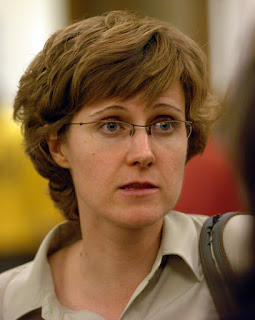 I don’t know the Tribune's State Political Reporter Kate Nash, left, very well. The longest conversation we had was after last year’s State Legislative session, when the Senate was still wrangling about coming back into special session. She had previously announced in the press box that she was going on a well-deserved vacation to some Caribbean island. On her return, I had asked her why she didn’t look so well tanned. She made some comment about strong sunscreen and her effort to avoid the harmful rays.
I don’t know the Tribune's State Political Reporter Kate Nash, left, very well. The longest conversation we had was after last year’s State Legislative session, when the Senate was still wrangling about coming back into special session. She had previously announced in the press box that she was going on a well-deserved vacation to some Caribbean island. On her return, I had asked her why she didn’t look so well tanned. She made some comment about strong sunscreen and her effort to avoid the harmful rays.Other than that, we simply nod to each other at political events that we both cover. I picked on her a few times on this blog about being geographically challenged when she had misidentified a federal courthouse. I also picked on her friend, Journal Photographer Roberto Rosales, for pushing my camera out of his way when it got into his shot. I’ve also said nice things about her reporting, especially the interview that she and Kate Nelson scored with Gov. Bill Richardson in Feb. 2007.
Nash is an honors graduate of the UNM Journalism school and was the editor of the Daily Lobo. She currently sits on the University’s Publication Board as the professional community member.
Valdes-Rodriguez wrote a glowing recounting, "The Irrepressible Kate Nash," of her days as feature editor at the Tribune, watching and marveling at Nash’s work ethic and writing.
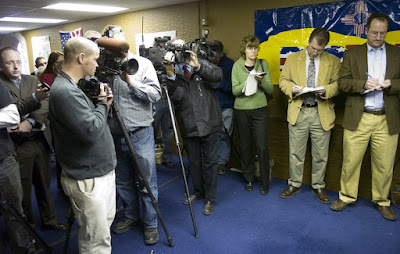 Nash is seen here in the middle of a press row, representing the Tribune at Democratic NM Congressional District 1 nominee Patrica Madrid's concession speech last November.
Nash is seen here in the middle of a press row, representing the Tribune at Democratic NM Congressional District 1 nominee Patrica Madrid's concession speech last November.Santa Fe New Mexican’s political reporter and blogger, Steve Terrell announced that Nash will join his paper in January.
So what’s wrong with this picture?
 This is the Tribune flag, with the Scripp’s lighthouse icon, at the end of the line in front of the Albuquerque Publishing Company. It seems that the light may soon be gone.
This is the Tribune flag, with the Scripp’s lighthouse icon, at the end of the line in front of the Albuquerque Publishing Company. It seems that the light may soon be gone.
1 comment:
Keep up the good work. Have a great 2008! Cheers :-)
Post a Comment